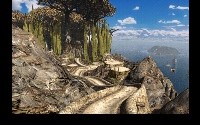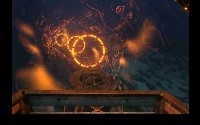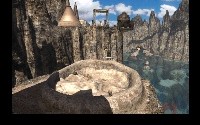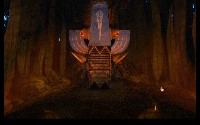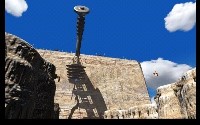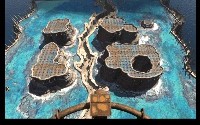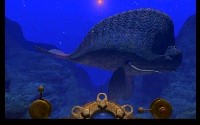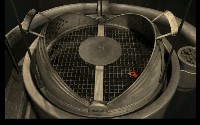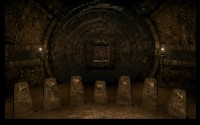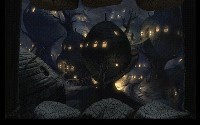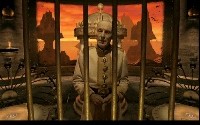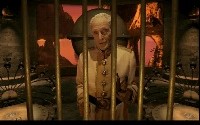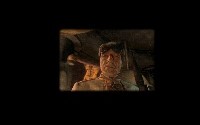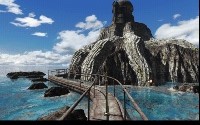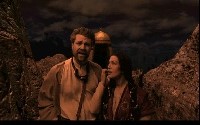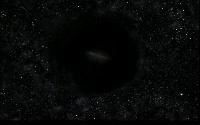Riven
Playtime: 8.1 Hours
Finished 05 March 2023.Finished the game with the good ending only - you can do some of the endgame stuff out of order and get a wide variety of bad ends but I didn't end up trying any of them. Atrus is a bit of a jerk, isn't he? (I'm kidding, the Stranger is fine in Myst 3.) Played the Steam version that uses ScummVM (initial Steam release didn't), performance was rock solid. I played in windowed mode with a resized game window; the upscaling was quite but some things were naturally still hard to notice. Unfortunately, it looks like my screenshots didn't turn out quite as well; my experience with the game looked a little better than what the screenshots show. Pretty interested in the remake but I'm not sure if I'm interested in playing it as soon as it releases or anything.
Also, this is yet another game for which I made really good use out of a physical notebook to take notes, sketch figures, and archive puzzle solutions. I've got some relatively detailed notes on the intricacies of some puzzles and puzzle elements, the Rivenese numbering system, etc. I wish more games encouraged these kinds of notes; I had a lot of fun logging stuff in this game!
I've always heard that Riven was much more difficult and confusing than Myst, so I've been somewhat hesitant to try it. Having now played it, I can say that I'm very glad that I did, and a little disappointed that I didn't try it out earlier; if I had given it a shot about ~10-15 years ago when I played realMyst for the first time, I imagine I'd think of Riven as fondly as I do of the original Myst. While I was still very much absorbed in the world of Riven, I think there's inevitably something lost playing it when I'm a little older and far more jaded to the mechanics of the game. With that said, while it's by no means perfect, I think it's a very worthy successor to Myst that distinguishes itself in a few key ways.
The first thing that is immediately noticeable is the vast improvements in visual fidelity compared to the original Myst, which was released 4 years earlier in 1993. While the original Myst was groundbreaking for its 3D visuals, it definitely did not stand up very well to the test of time - it looks like something you might make in Alice (3D animation software) today. In contrast, I think Riven's visuals holds up remarkably well in comparison - textures are more detailed, models look smoother and more realistic, and lots of visual effects still look great today. Lots of this comes down to the difference, or perhaps presence of style in Riven - the dying age of Riven feels a little bit more gritty and worn down than the ages of Myst, which has a pretty disjointed style due to technical limitations (later versions of Myst are far better at portraying the intended atmosphere). There is no shortage of FMV sequences in Riven showing off some incredible visual effects - in particular, I think the minecart from Village Island to Crater Island utilizes a beautiful visual effect with the water-repelling rings forming an underwater tunnel around the railway. The shot in the screenshot doesn't really do it justice.
The feel of the game is also remarkably different than Myst as well, even with an identical control scheme. The original Myst feels very much like a tech demo in a way - the game consists of several small worlds, each existing entirely independently of the others and showcasing different environment styles. It also feels quite "gamified", if that makes sense - there's a stark awareness that Myst Island is a hub world of sorts, and each Age is a stage, within which the goals are simply to grab the red or blue pages, and to locate the linking book back to Myst Island. It's communicated clearly, and with each puzzle solved there is clear and relatively linear progress towards the goals at all times. In contrast, I feel like Riven is far less friendly in this aspect. You have a general goal of trapping Gehn and somehow escaping, but you're given no real direction on how to do that. Also, as each of the islands is interconnected, there is less of a feeling that each island is a "stage", though they are distinct in their design. This trend is completed by the fact that there are very few "bite-sized" puzzles, as there were in Myst; instead, the entire game boils down to a few main objectives: understand and solve the Standing Stones puzzle to reach Tay, solve the Spinning Domes and Fire Marble puzzle to reach Age 233, and with a variety of codes figure out how to trap Gehn, free Catherine, and escape into the Star Fissure. While there are still some small mechanical contraptions you can toy around with (like the submarine), these feel less like puzzles and more like simple tasks to unlock navigation. I definitely felt a degree of irritation trying to find out what to do, but ultimately appreciate how everything feels far less segmented, and more well-coordinated into a progressively-unfolding adventure. There's fewer moments of satisfaction, but each one is so much more exhilirating, because of the sheer number of different elements involved in solving them.
Riven also feels significantly more ominous and hostile than Myst, which is to be expected of a decaying Age. Even though you only ever interact with one person in the flesh in Myst, there is plenty of dialogue with Sirrus and Achenar, and each Age is empty but serene when you visit, with subtle hints of the events that led to the demise of its denizens (usually some degree of avarice from Sirrus, and brutality from Achenar). There's lots of dialogue interspersed across the voyages to each Age to keep you interested in the development of the characters. On the other hand, there are plenty of signs in Riven - guards warn the village as you approach, you see some children around that are promptly scuttled away by their parents, and you unexpectedly meet a number of other characters; some hostile, others less so. However, it's not really until near the endgame where you have any real interaction with them, starting once you travel to Tay (following the standing stones puzzle). Really, in Riven half of the human interactions are hostile - the scuffle with the guards at the beginning, the Moiety shooting and imprisoning you, and the confrontation with Gehn. Just like its predecessor, lots of the story is written out in extremely lengthy journals and hidden in environmental details, which lends itself well to the mysterious tone of the game overall. I think the balance of tension, peacefulness, and mystery is very well done.
While I think the elements of Riven generally come together to form a great experience, it's still not without some faults as well. To give some context, my first experience with Myst was the realMyst edition (original, released 2000) - this had a fully 3D world with mouselook in contrast to the fully pre-rendered environments of Myst 1993, so I had a chance to familiarize myself with the world before playing the Masterpiece edition. As a result, the fixed-perspective gameplay wasn't really disorienting. In contrast, there is currently no other version of Riven available as of writing this - though a remake was announced recently. I frequently got lost or disoriented while playing through the game, since there's usually no indication on whether a screen rotation is 90 or 180 degrees. Occasionally, a "rotation" cursor actually moves you to a different position, which is even more confusing! Another common complaint about movement in Riven is regarding the over-use of extremely long hallways. Far too many sections in this game require over 10-20 clicks just to get to the next interaction; the Zip Mode feature can alleviate the issue, but does not solve it when you need to go around an island or transit between them. Animations tend to be slow and lengthy, which shows off some really cool effects but gets really old eventually. On top of this, lots of interactable objects, levers, or pathways are extremely difficult to find in this game, perhaps due to the relatively low resolution of the game (compared to today). This exacerbates the navigation problem - sometimes, I've run around for a while just to realize there's a tiny button that I can push, which is textured almost exactly the same as the surrounding wall. Lastly, drawing off the low resolution note, the script used in Atrus's and Catherine's journals is incredibly difficult to decipher between the heavy cursive and pixelated graphics - I can't imagine what it would be like playing this with English as a non-primary language.
A last note that I'd like to make is that Riven's narrative is quite interesting, and the endgame sequence is truly climactic. The massive story dump that is Catherine's journal gives much needed context to the condition Riven, the ominous giant stone knives everywhere and the existence of the world of Tay (which is the location shown in the incredible cover art). Gehn is played incredibly well by John Keston, manifesting a character that appears to be repentant for his callous views and destructive plans, yet with clear menacing undertones. He approaches you in a practiced, amicable fashion - a paper-thin facade of the man he truly is, as portrayed in his journals. The game's twist is surprising yet brilliant, harnessing the known mechanic of each Prison Book only housing one inhabitant at a time to gain Gehn's trust by trapping yourself, only for him to foolishly swap with you. Breaking Catherine out of Prison Island and opening the Star Fissure with the telescope was the perfect climax, though I can't help but feel that Atrus is a bit of dick for not allowing us to escape with him. But I guess it's a perfect way to bookend the adventure between Myst, which began in the the Expanse, and Riven, which ends with the Stranger returning to it. I think the Starry Expanse could be an allegory for the world outside the game, and the Fissure the monitor on which the game is displayed. As you first enter Myst, or finally leave Riven, you're also traveling to and from the world imagined so meticulously by Cyan through these two games. I feel like it was generally meant to serve as a goodbye from the writers, at least until Myst 3 came along and continued the saga.

